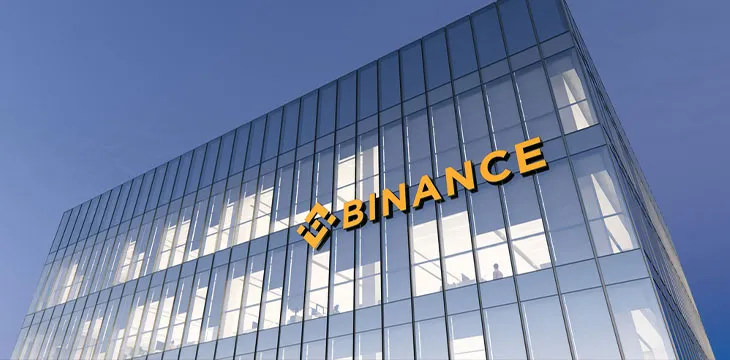|
Getting your Trinity Audio player ready...
|
Binance’s controversial boss is pushing back against reports that his unexplained movements of digital assets resemble actions taken by rival cryptocurrency exchange FTX shortly before its collapse.
Late Tuesday, bankrupt crypto lender Voyager Digital announced that most of its creditors had voted in favor of its restructuring plan. The plan will see the Binance.US exchange acquire around $1 billion in frozen assets that will (eventually) be returned to Voyager’s former customers. Voyager attorneys will seek bankruptcy court to approve the plan at a Thursday hearing.
The acquisition plan was tentatively approved in January, but a host of objections have been voiced by the U.S. Securities and Exchange Commission (SEC), the Federal Trade Commission (FTC), the New York Attorney General (NYAG) and the New York Department of Financial Services (NYDFS)—pointing on the potential illegality of Voyager’s operations in New York, Voyager’s possible use of deceptive marketing practices and concerns over whether Binance.US actually has the funds to seal the deal.
The SEC also cited concerns about the “numerous public reports and press accounts concerning investigations into the purchaser and its affiliates.” Apart from widespread evidence of Binance boss Changpeng ‘CZ’ Zhao’s legendary disdain for regulatory compliance, last month brought confirmation that Binance.US is CZ’s corporate sock-puppet, an entity that doesn’t even have control over its own bank accounts.
These concerns led to last month’s combined action by the SEC and NYDFS against Paxos Trust, the New York-based issuer of the BUSD stablecoin. The NYDFS specifically cited “several unresolved issues related to Paxos’ oversight of its relationship with Binance” in ordering Paxos to “end its relationship with Binance.”
Paxos issues BUSD at a rate of 1:1 with the U.S. dollar, which requires it to hold sufficient reserves to maintain that peg. But Binance issued its own version of BUSD called Binance-Peg BUSD, the quantity of which on multiple occasions exceeded its reserve assets by over $1 billion each time.
F-off, B-tokens
Binance has issued nearly 100 similar ‘B-tokens’ that mirror other stablecoins and tokens on other protocols. These mainly serve to boost the usage of Binance’s proprietary Binance Smart Chain while also boosting the value of Binance’s in-house token BNB. The latter currently boasts a market cap of $47.6 billion, despite being backed by little more than CZ’s assurances of solvency.
This brings us to a new report by Forbes, noting a series of unexplained transfers of Binance-controlled assets that were “eerily similar to maneuvers” employed by FTX, the Sam Bankman-Fried (SBF)-owned exchange that dramatically imploded last November following a lengthy run of financial illegalities.
The report cited a series of asset transfers Binance made between August and December 2022. The transfers involved $1.8 billion worth of digital assets backing the B-Peg version of USDC, a stablecoin issued by the Centre consortium (a partnership of Circle and the Coinbase (NASDAQ: COIN) exchange).
The bulk (over $1 billion) of these USDCs were sent to Chicago-based trading firm Cumberland/DRW (as of 2021, the second-largest recipient of newly issued Tether stablecoins). Binance sent the remaining chunks of its USDC to Singapore-based Amber Group, the now-defunct Alameda Research (another SBF-owned firm that was the largest Tether recipient), and Justin Sun’s distributed autonomous organization Tron.
The purpose behind these transfers remains unclear. What is apparent is that there was no corresponding $1.8 billion reduction in the amount of issued B-Peg USDC. And by parting even temporarily with these assets, Binance had broken its assurances to customers that the USDC collateral backing its B-Peg USDC was equal to the number of tokens issued.
Forbes also suggested that the movement of these assets from one Binance-controlled wallet to another indicates that Binance is commingling collateral with customer funds, using a separate ledger to allow it to keep track of who it owes what.
Patrick Hillman, the ‘chief strategy officer’ with the unfortunate task of speaking for Binance in these situations, effectively confirmed these suspicions, telling Forbes “there was no commingling” because “there’s wallets and there is a ledger.”
Hillman’s assertions aside, this still makes a mockery of Binance’s previous assertions that its B-tokens were always “100% backed by the native coin in reserve.” It also flies in the face of last November’s widely mocked ‘proof of reserves’ that lacked any corresponding list of Binance liabilities and was quickly disowned by the company Binance got to sign off on this farce.
Others have previously suggested that Binance may have been engaging in some dodgy activities that brought down other crypto firms. In January, ChainArgos noted that the B-Peg USDC transfers suggested: “someone received a loan of something like $1B for about 100 days.”
Piquing CZ’s interest
Forbes’ reporting follows last week’s Fortune investigation that accused Binance of using customer assets to grab stablecoin market share from USDC and other rivals (except Tether because apparently there is honor among crooks).
Last year’s dramatic rise in interest rates has been highly beneficial for exchanges that hold customers’ fiat/stablecoin deposits and can reinvest those deposits into T-bills to reap the rewards. Coinbase’s vast stores of USDC generated interest income of $327 million last year, a staggering 1,167% rise from 2021. Clearly, there was gold in them thar stablecoins, and Binance wanted it.
Last September, Binance announced it would start forcibly converting its customers’ USDC (as well as some smaller stablecoins) to BUSD. Binance claimed that it would continue to hold USDC reserves and that customers could withdraw the funds in their account at any time in whatever token they preferred—including USDC.
Within weeks of CZ’s USDC announcement, BUSD’s market cap shot up by one-fifth to around $23.5 billion. Sadly, this boost was short-lived. Since last month’s regulatory pushback on Paxos, BUSD’s market cap had fallen to $10.2 billion, basically half the sum before Binance began its sharp-elbowed stablecoin maneuvers.
Fortune’s sleuthing found that in just a couple of days last August—before the auto-conversion policy was announced and without customers’ knowledge or permission—Binance transferred at least $750 million of the USDC collateral backing its B-Peg USDC to Circle, which would then ‘burn’ the tokens and give Binance actual dollars. Binance would use these dollars to buy more BUSD from Paxos.
The net result was that Binance didn’t have sufficient USDC to meet potential withdrawal requests. This only became apparent when Binance was forced to halt USDC withdrawals in December, a hiccup the exchange tried to pin on its New York bank’s holiday hours.
While not going as far as to suggest that Binance lacked the funds needed to (eventually) meet its withdrawal obligations, Fortune did express concerns that Binance’s wholesale in-out wallet transfers indicated a messy commingling of customer funds and other assets supposedly backing its B-tokens.
Now recall FTX’s abysmal lack of attention to what assets belonged to whom. Following FTX’s collapse, bankruptcy court-appointed CEO John J. Ray III said FTX suffered from such an “utter lack of record keeping” that the net result was “a complete absence of trustworthy financial information.”
Also, recall that SBF allowed Alameda to dip into FTX customer deposits to hide the trading desk’s billions in bad bets. To cover this theft, FTX relied on the massive holdings of its in-house FTT token, the value of which outside FTX was negligible. We stop here to remind everyone that Binance’s in-house BNB token—occasionally likened to supermarket reward points—has a $47.6 billion market cap.
It’s entirely possible that nothing Binance got up to here is strictly illegal. But, given the exchange’s demonstrated disinterest in adhering to even the most basic elements of disclosure and propriety, there’s little justification and even less enthusiasm for giving Binance the benefit of the doubt.
Take off, hoser
On Wednesday, Binance issued a rambling and highly repetitive blog post that dismissed Forbes’ findings as “massive leaps to conclusions” that “fuel conspiracy theories.” Binance claimed the asset transfers referenced in the article were “simply a case of institutional clients withdrawing their own assets from our platform.”
The blog further insisted that Binance “holds all of its clients’ assets in segregated accounts.” Perhaps, but not always. In January, when Binance first admitted to underfunding its BUSD reserves, Bloomberg quoted a spokesperson admitting the commingling of customer funds and asset reserves, but claiming that this had been done “in error.”
Wednesday also saw CZ embark on a lengthy Twitter rebuttal, slamming Forbes for “accusatory questions, with negative spins, intentionally misconstruing facts.” CZ said Forbes was dredging up “some old blockchain transactions,” as if last autumn/winter was some bygone era in which dinosaurs roamed the earth (alongside Raquel Welch in a fur bikini).
CZ tried to play the victim by flipping the race card on Forbes, expressing their eagerness to describe his Chinese ethnicity. In reality, Forbes mentioned China only once and only in describing CZ as a “Chinese Canadian billionaire.” Presumably, CZ was less offended by being called Canadian. (If CZ was a true Canuck, he’d have said ‘sorry’ for having taken offense.)
But CZ was born in China and did spend the first 12 years of his life there. Forbes’ reference to this fact is no different than its descriptions of the Australian-born Rupert Murdoch as an “Australian-American global media tycoon,” despite the crotchety media mogul currently calling Montana home.
CZ is likely far more sensitive about earning the ire of Chinese authorities by indirectly associating them with his disregard for the law. CZ is likely also keen to continue obfuscating his legal ties to any country, lest that leave him vulnerable to legal action by local authorities.
Finally, CZ complained that Forbes’ article “tried hard to categorize Binance and FTX together… We are different.” That’s true. Binance hasn’t collapsed in scandal, leaving hundreds of thousands of customers out billions of dollars. At least, not yet.
Follow CoinGeek’s Crypto Crime Cartel series, which delves into the stream of groups—from BitMEX to Binance, Bitcoin.com, Blockstream, ShapeShift, Coinbase, Ripple,
Ethereum, FTX and Tether—who have co-opted the digital asset revolution and turned the industry into a minefield for naïve (and even experienced) players in the market.

 05-09-2025
05-09-2025 





